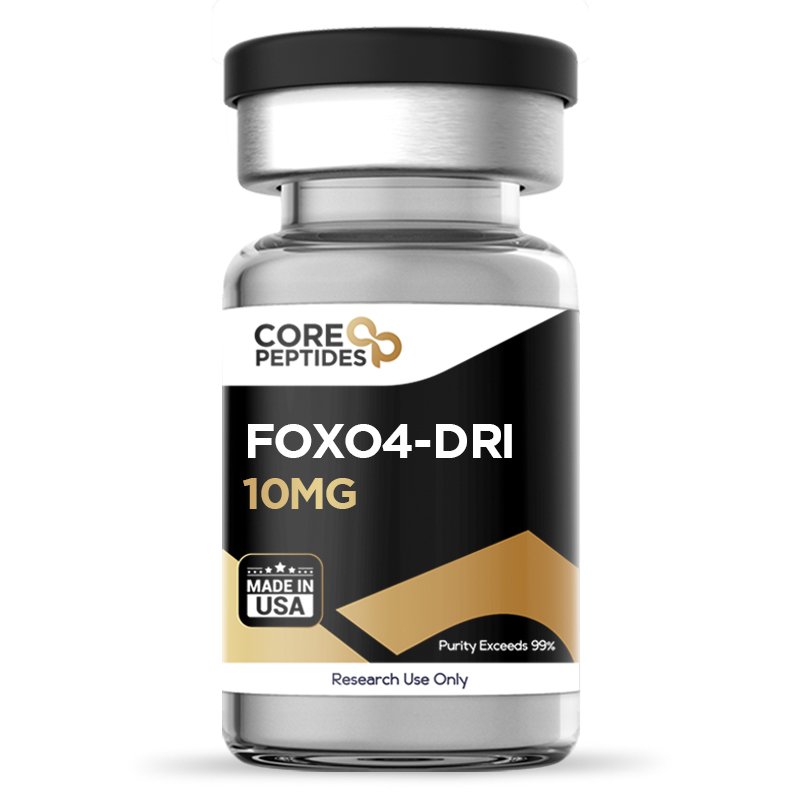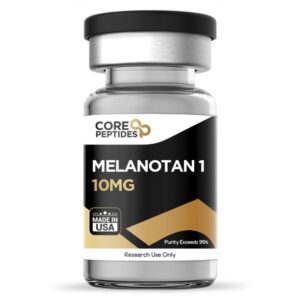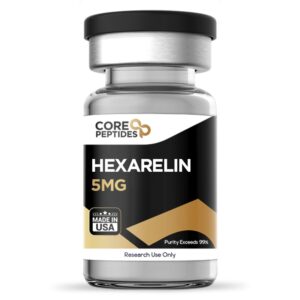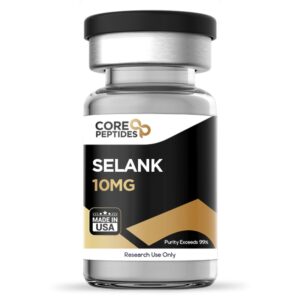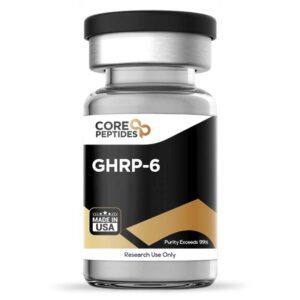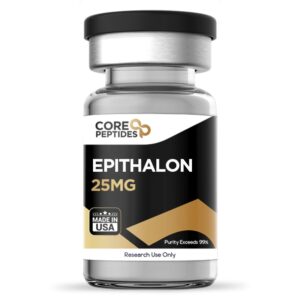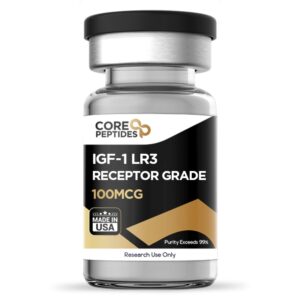FOXO4-DRI (10mg)
$235.00
Size: 10mg
Contents: FOXO4-DRI (10mg)
Form: Lyophilized powder
Purity: >99%
SKU: P-FOXO4-10
FREE Shipping on $200+ orders
Discount per Quantity
| Quantity | Discount | Price |
|---|---|---|
| 5 - 8 | 5% | $223.25 |
| 9 + | 10% | $211.50 |
FOXO4-DRI Peptide
Organisms host multiple transcription factor proteins. One such class of transcription factor proteins is the FOXO group or forkhead family of transcription factor-O,(2) which includes four members: FOXO1, FOXO3, FOXO4, and FOXO6. The FOXO4 factor is considered to regulate various cell pathways, including insulin signaling, cell cycle progression, and other functions that regulate growth and differentiation.
A synthetic version of the FOXO4 protein is FOXO4-DRI, which was developed to be identical to a fragment of the endogenously available FOXO4 protein, except for the alteration in its amino acid structure. It includes only a specific part of the FOXO4 sequence crucial for interacting with p53. FOXO4-DRI peptide, or Proxofim, is an acronym for Forkhead box O transcription factor 4-D-Retro-Inverso peptide.(3) FOXO4-DRI peptide is the same as FOXO4 protein, except that the L amino acids in its structure are replaced by D amino acids. As a result of this, FOXO4-DRI peptide may be less susceptible to the normal clearance mechanism as compared to FOXO4. It is important to note that this alteration not only potentially increases its stability but also may affect how it interacts with other cellular components compared to its natural counterpart.
Overview
The retro inverso peptides (DRI peptides) are linear chains of amino acids, where the sequence is "reversed," reversing the chirality of the structure (i.e., L amino acid structure altered to D amino acid and vice versa). D amino acids represent the mirror image of the naturally occurring L amino acids in the biological proteins. The main potential advantage of exchanging L amino acid with D amino acid is that the latter may be more resistant to degradation, making the protein structure more durable.
The main focus of FOXO4-DRI peptide research is focused on its potential to prevent the binding of the FOXO4 protein with p53 protein.(4) This interaction may be crucial as FOXO4, when bound to p53, may inhibit some of p53's key functions involved in cell cycle regulation and apoptosis. The p53 protein is an endogenous regulator protein, considered to regulate the progression of the cell cycle, including cell death. p53’s potential as a tumor suppressor is well-documented, primarily functioning to stop the proliferation of cells that have suffered DNA damage. When FOXO4 protein binds with p53, it does not appear to allow p53 to bind with DNA, thereby preventing apoptosis and cell death. This interruption may lead to the accumulation of senescent cells - those that have stopped dividing but do not die, contributing to cell aging. This process may be inhibited in the presence of FOXO4-DRI peptide, allowing p53 to bind with DNA and thereby help the cell cycle to continue to death. This potential restoration of p53’s function by the FOXO4-DRI peptide might enable it to trigger the programmed cell death of senescent cells, essentially clearing out cells that might otherwise contribute to the decline in tissue function seen in aged cell cultures.
FOXO4-DRI peptide is selective in nature and exerts this potential action only on cells that have become dysfunctional over time due to aging, known as senescent cells.(5) As a result of this biological pathway, the functioning of the tissues may be improved, aiding cell growth and differentiation.
Chemical Makeup
Molecular Formula: C228H388N86O64
Molecular Weight: 5358.05 g/mol
Other Known Titles: Forkhead box protein O4, Proxofim, FOXO4a, AFX, AFX1, MLLT7
Research and Clinical Studies
FOXO4-DRI Peptide and Senescence
FOXO4-DRI peptide research indicates that the peptide may not wholly stop cell senescence; however, it does appear to have the potential to slow down the process by possibly preventing naturally occurring FOXO4-mediated resistance to apoptosis during senescence. More specifically, researchers have observed that senescent cells resisted apoptosis due to elevated FOXO4 levels, which seem to regulate this process by interacting with p53.(6) By inducing apoptosis in senescent and damaged cells, this peptide may increase the regeneration of cells. One 2017 study(6) experimented on aged mouse models, including a fast-aging model (XpdTTD/TTD mice), presented with either the protein compound or a control. The experimental murine models appeared to have exhibited improved fitness, better renal functioning, and increased fur density. This may be related to its potential to decrease the burden of senescent cells. These cells appear to contribute to the aging process and age-related diseases through the senescence-associated secretory phenotype (SASP), which fosters a pro-inflammatory environment detrimental to tissue function and integrity. By potentially reducing the presence and impact of senescent cells, FOXO4-DRI might thereby restore tissue homeostasis and reduce biomarkers of cell aging.
FOXO4-DRI Peptide and Cardiovascular Function
Research from 2002(7) has suggested that levels of proteasome enzymes decrease over time. These enzymes are considered to play a primary role in removing cells identified as damaged or dysfunctional within an organism. The naturally occurring FOXO4 protein appears to regulate the levels of proteasome enzymes, but it does not necessarily help reduce damaged cells. Studies in the FOXO4-DRI peptide suggest it may boost natural processes while possibly also eliminating dysfunctional cells.
FOXO4-DRI and Insulin Signaling
In the context of longevity, FOXO4's activities are often linked through the insulin and insulin-like growth factor signaling (IIS) pathway. This pathway influences how cells respond to stress and growth signals, potentially extending lifespan by enhancing stress resistance and cellular survival mechanisms.(8) Furthermore, FOXO4's role in the IIS pathway suggests it might modulate the actions of diet and environmental factors on cell aging, acting as a mediator between external factors and cellular longevity pathways.
FOXO4-DRI and Oxidative Stress
Scientific hypotheses posit that FOXO4 may act as a regulatory linchpin cellular response to oxidative stress. By mediating the transcription of crucial antioxidative enzymes, FOXO4 may help mitigate oxidative stress and maintain cellular integrity and function during episodes of high oxidative load or inflammation. This dual potential in responding to both oxidative stress and inflammation may enhance the protective capabilities of FOXO4, making it a potential factor in the cell’s longevity and resilience.
2017(9) studies suggest that when cells encounter oxidative stress—marked by excess free radicals—this imbalance may trigger several defensive responses within the cell. One key player in this response is posited to be MST1, a protein that increases its activity in the presence of oxidative stress. MST1's activation may create a cascade within the cell, signaling through the p38 AMPK and JNK pathways. These pathways are posited to play a role in communicating stress signals and preparing the cell to counteract the incoming damage. Further into the cascade, H2O2, a common reactive oxygen species, activates the small GTPase Ral. The activation of Ral leads to the phosphorylation of FOXO4 at specific sites. This phosphorylation, which occurs via the JNK pathway, is considered to be crucial as it modifies FOXO4, preparing it for its role in the cell's nucleus.
Interestingly, the same pathway may also be utilized during inflammatory responses, mediated by the tumor necrosis factor-alpha (TNF-α). This overlap suggests that FOXO4’s activation by oxidative stress and inflammation might follow similar mechanisms, pointing to a broader role of FOXO4 in stress and immune response contexts. Once phosphorylated, FOXO4 translocates to the nucleus—the command center of the cell. In the nucleus, FOXO4 activates the transcription of genes encoding antioxidant enzymes like manganese superoxide dismutase (MnSOD), catalase (CAT), and glutathione peroxidase (GPX). These enzymes may play critical roles in detoxifying reactive oxygen species, thereby protecting the cell from oxidative damage. FOXO4-DRI may inhibit the FOXO4 translocation to the nucleus, potentially reducing oxidative stress defenses but primarily in senescent cells.
FOXO4-DRI and Neurological Function
While the pathophysiology of certain neurological diseases remains unclear, it is presumed by researchers that there are changes in the proteasome enzyme activity over time, which may lead to cognitive impairment. Research(10) has suggested that proteasome activities are downregulated in neurological disorders. It is unknown whether this downregulation is the primary cause of the disorder, but it is likely to be a contributing factor. Clinical research has suggested that the levels of FOXO proteins in the central nervous system may be altered in research models of neurodegenerative disorders (NDDs).(11) This has led to the hypothesis that exogenous FOXO protein, such as FOXO4-DRI peptide, may help regulate optimal levels of FOXO proteins, thereby preventing or alleviating the progression of any NDDs associated with this mechanism.
FOXO4-DRI Peptide and Hypogonadism
A study(4) was conducted to explore the potential of FOXO4-DRI peptide in age-related male late-onset hypogonadism. An in vitro model composed of senescent Leydig cells was used. Leydig cells are considered crucial for testosterone production. These Leydig cells were previously isolated from male mice and given a hydrogen peroxide chemical to induce senescence. The researchers observed that FOXO4 transitions into the nucleus following the induction of the senescence in the cell. This nuclear presence of FOXO4 seems to be involved in maintaining the viability of senescent cells by possibly modulating downstream senescence-associated pathways, detailed by changes in p53, Ser15-phospho-p53, and p21 protein levels. When these isolated senescence cells were presented with FOXO4-DRI peptide, researchers reported that the peptide appeared to block FOXO4 proteins, allowing p53 to bind with DNA, which led to the nuclear exclusion of p53 and induction of apoptosis of the senescent Leydig cells. This suggests that FOXO4-DRI may selectively target and eliminate senescent cells, potentially alleviating some dysfunctions associated with aged Leydig cells, such as reduced testosterone synthesis.
FOXO4-DRI peptide is available for research and laboratory purposes only. Please review and adhere to our Terms and Conditions before ordering.
References:
- Babu MM, Luscombe NM, Aravind L, Gerstein M, Teichmann SA. Structure and evolution of transcriptional regulatory networks. Curr Opin Struct Biol. 2004 Jun;14(3):283-91. https://pubmed.ncbi.nlm.nih.gov/15193307/
- Sun, Yan et al. “FOXO4 Inhibits the Migration and Metastasis of Colorectal Cancer by Regulating the APC2/β-Catenin Axis.” Frontiers in cell and developmental biology vol. 9 659731. 23 Sep. 2021. https://www.ncbi.nlm.nih.gov/pmc/articles/PMC8495124/
- Huang, Yuzhao et al. “Senolytic Peptide FOXO4-DRI Selectively Removes Senescent Cells From in vitro Expanded Human Chondrocytes.” Frontiers in bioengineering and biotechnology vol. 9 677576. 29 Apr. 2021, https://www.ncbi.nlm.nih.gov/pmc/articles/PMC8116695/
- Zhang, C., Xie, Y., Chen, H., Lv, L., Yao, J., Zhang, M., Xia, K., Feng, X., Li, Y., Liang, X., Sun, X., Deng, C., & Liu, G. (2020). FOXO4-DRI alleviates age-related testosterone secretion insufficiency by targeting senescent Leydig cells in aged mice. Aging, 12(2), 1272–1284. https://www.ncbi.nlm.nih.gov/pmc/articles/PMC7053614/
- Krimpenfort P, Berns A. Rejuvenation by Therapeutic Elimination of Senescent Cells. Cell. 2017 Mar 23;169(1):3-5. https://pubmed.ncbi.nlm.nih.gov/28340347/
- Marjolein P. Baar et al, Targeted Apoptosis of Senescent Cells Restores Tissue Homeostasis in Response to Chemotoxicity and Aging. Vol 169 Issue 1, https://doi.org/10.1016/j.cell.2017.02.031
- Anne-Laure Bulteau, Luke I. Szweda, Bertrand Friguet, Age-Dependent Declines in Proteasome Activity in the Heart, Archives of Biochemistry and Biophysics, Volume 397, Issue 2, 2002, Pages 298-304, ISSN 0003-9861, https://doi.org/10.1006/abbi.2001.2663
- Murtaza G, Khan AK, Rashid R, Muneer S, Hasan SMF, Chen J. FOXO Transcriptional Factors and Long-Term Living. Oxid Med Cell Longev. 2017;2017:3494289. doi: 10.1155/2017/3494289. Epub 2017 Aug 15. https://pubmed.ncbi.nlm.nih.gov/28894507
- Lee, S., & Dong, H. H. (2017). FoxO integration of insulin signaling with glucose and lipid metabolism. The Journal of endocrinology, 233(2), R67–R79. https://www.ncbi.nlm.nih.gov/pmc/articles/PMC5480241/
- Ciechanover A, Brundin P. The ubiquitin proteasome system in neurodegenerative diseases: sometimes the chicken, sometimes the egg. Neuron. 2003 Oct 9;40(2):427-46. https://pubmed.ncbi.nlm.nih.gov/14556719/
- Wei Hu, Zhi Yang, Wenwen Yang, Mengzhen Han, Baoping Xu, Zihao Yu, Mingzhi Shen, Yang Yang, Roles of forkhead box O (FoxO) transcription factors in neurodegenerative diseases: A panoramic view, Progress in Neurobiology, Volume 181, 2019, 101645, ISSN 0301-0082, https://doi.org/10.1016/j.pneurobio.2019.101645
